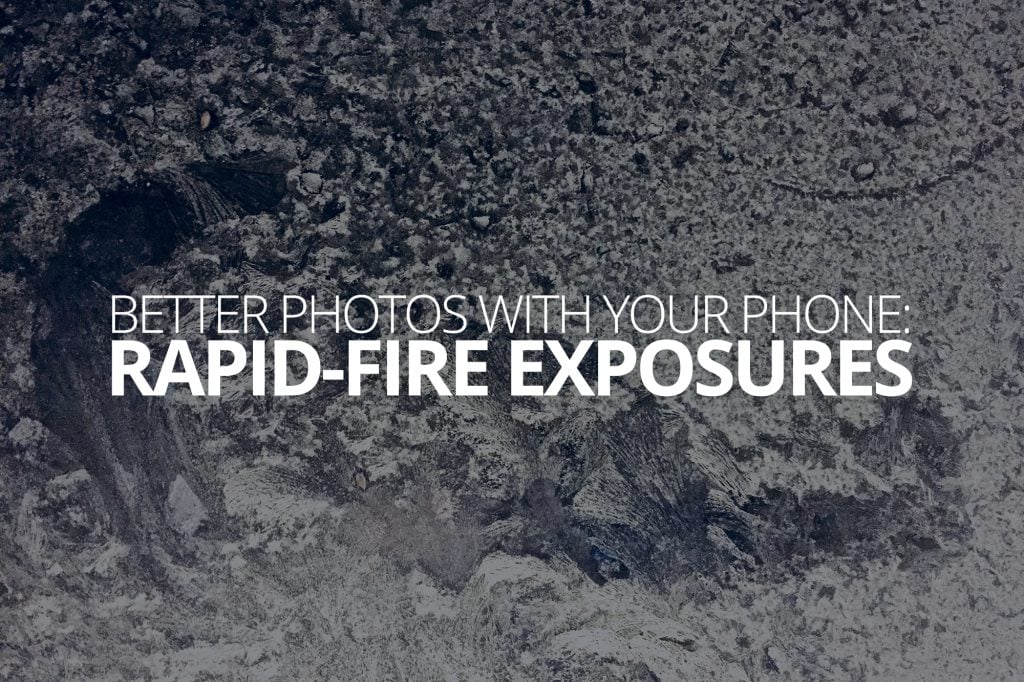Welcome back for another installment of Better Photos with Your Phone. Last time we talked about locking the exposure, a feature available by default on most smartphones, which allows you to take a little more control over how the photo looks without having to know a bunch of technical jargon. Hopefully over the last couple weeks you’ve had some opportunities to use this feature and it’s helped you to take some photos you’re proud of and might not have taken at all otherwise.
This week, we’re going to talk about another feature offered by most smartphones. But this time, instead of being something you probably didn’t even know about, It’s something you’re probably already doing on accident all the time: rapid-fire exposures, or, holding the button down and taking a gazillion photos really fast, sometimes called “burst mode” depending on your phone.
10 years ago, this feature was pretty much exclusive to professional and semi-professional cameras. Today, believe it or not, your phone can probably take more photos, and faster, than our expensive professional cameras can. This feature is a double edged sword though, as any professional photographer can tell you. Rapid-fire exposures are a very useful tool for tricky situations, as well as a reliable way to shoot yourself in the foot and undermine the whole reason for taking a photo in the first place.
Lets unpack this feature a little bit.
What are rapid-fire exposures
This is not a complicated feature to understand. When you pull out your phone and point the camera, just press and hold on the shutter button. You might hear a rapid clicking noise from your phones speaker, or you might see a little blinking animation around the button or maybe a little counter quickly climbing as long as you’re holding the button down. If your toddler has ever gotten their hands on your phone and you wondered how they managed to take 600 blurry pictures of nothing—this is your answer.
Basically, it’s just taking a new photo at the quickest interval the phone’s hardware will allow. Try it. Pull out your camera, point it at something and hold that button down for a good 10 or 15 seconds. Congratulations, you’ve just used the rapid-fire exposure feature and you have an absolute mess of mostly worthless images. Whether something is in there that’s actually worth looking at is a whole different question.
The problem
One thing that professional photographers do that is almost always overlooked and most other people do not do is cull their images. We diligently pick out the best images and discard the rest. The impact of any particular photo is blunted by the quantity of similar images in close proximity. The more images you have, the less any one of them matters.
Lets do a little experiment. Think about your favorite movie. Now, think about your favorite frame of that movie. You probably can’t. You probably can’t even do it with your favorite video of your own kids. That’s because video, as a medium, is given meaning by hundreds of thousands of individual frames strung together to give them a collective meaning. A photograph is exactly the opposite, with some rare exception. So, the longer you keep the rapid-fire exposure going the more impact is drained away. That’s why photographers cull (and we’ll get into that next time).
For you though, without a habit of picking out the best images and discarding the rest, you’re reducing the chances of really enjoying any of the images—or worse, just never really looking at or sharing them because finding the one you really like is a quest for a needle in a hay stack.
When it’s a good idea
Just because the rapid-fire exposure is easy to do on accident, and is more narrowly useful than it seems based on how easy it is to do, doesn’t mean you shouldn’t use it (or, like I explained at length, that you should use it all the time). Like all features on a camera, it has a time and place, and being aware of what you’re doing is the first step.
The situations that rapid-fire exposure was designed for, and where it sees its real benefit without those drawbacks discussed earlier are fluid and once-in-a lifetime moments.
Imagine you’re trying to get a great shot of your kid kicking a soccer ball. There is one tiny sliver of time in there where you’re going to get a great facial expression, and an awesome posture that perfectly captures what’s happening, but hitting the button at exactly that moment is next to impossible. So, as soon as they start to swing that foot to kick the ball, lay on that button. Or likewise, when your two year old leans in to blow out their birthday candles, let that baby rip. Or when when you’re trying to get a picture of your brother in law’s face when he learns he’s going to be a dad—this is the moment! In all of these cases, the chances that you got the perfect shot in there will go way up and the chances that you’ll do the work to find it are quite good, because the moment is unique and meaningful.
Avoid rapid-fire exposures for the quick and controlled moments. The photo of the kids on their first day of school, the selfie and the bar with your besties, the big smile after your oldest finally gets a drivers license. These are the moments where the impact is in the scarcity.
Next time
Next time we’ll be talking about The Culling Habit. Yes, we’re going to get a little more hobbyist-focused than this series intends to, but I’m also going to make a case for why the every-day-picture-taker should take a few minutes each week to do it, and how it proves beneficial. Until next time, happy picture taking, and taking, and taking, and taking, and taking, and taking, and taking.

